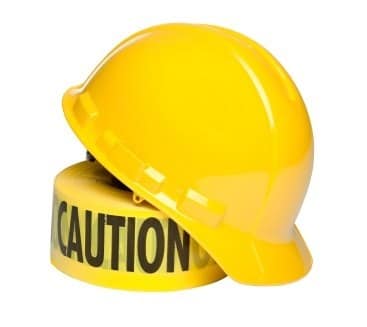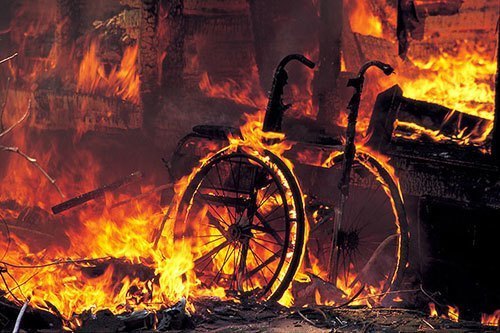
The Disabled & Evacuation Devices
 The new WHS legislation requires that the PCBU (Person Conducting a Business or Undertaking) demonstrates due diligence.
The new WHS legislation requires that the PCBU (Person Conducting a Business or Undertaking) demonstrates due diligence.
That being said, they must firstly have assessed the risks and identify any foreseeable hazards, then utilising the Hierarchy of control they must implement control measures. This specifically states the obligation to plan for all emergencies and provide training and practice that is appropriate to the nature of the risks associated with the work
In short we are obliged to take into a count the risk to everyone including people with disability within a work place and to ensure they can get out in an emergency, this includes assisting the risk and implementing controls. See the extract from the legislation below:
Work Health and Safety Regulation 2011
Chapter 3 General risk and workplace management
 Part 3.1 Managing risks to health and safety
Part 3.1 Managing risks to health and safety
32 Application of pt 3.1 This part applies to a person conducting a business or undertaking who has a duty under this regulation to manage risks to health and safety. 33 Specific requirements must be complied with any specific requirements under this regulation for the management of risk must be complied with when implementing the requirements of this part. Examples—
- a requirement not to exceed an exposure standard
- a duty to implement a specific control measure
- a duty to assess risk
34 Duty to identify hazards. A duty holder, in managing risks to health and safety, must identify reasonably foreseeable hazards that could give rise to risks to health and safety. 35 Management of risk. A duty holder, in managing risks to health and safety, must—
(a) eliminate risks to health and safety so far as is reasonably practicable; and
(b) if it is not reasonably practicable to eliminate risks to health and safety—minimise those risks so far as is reasonably practicable.
36 Hierarchy of control measures
(1) This section applies if it is not reasonably practicable for a duty holder to eliminate risks to health and safety.
(2) A duty holder, in minimising risks to health and safety must implement risk control measures under this section.
(3) The duty holder must minimise risks, so far as is reasonably practicable, by doing one or more of the following—
(a) substituting (wholly or partly) the hazard giving rise to the risk with something that gives rise to a lesser risk;
(b) isolating the hazard from any person exposed to it; (c) implementing engineering controls.
(4) If a risk then remains, the duty holder must minimise the remaining risk, so far as is reasonably practicable, by implementing administrative controls.
(5) If a risk then remains, the duty holder must minimise the remaining risk, so far as is reasonably practicable, by ensuring the provision and use of suitable personal protective equipment. Note— A combination of the controls set out in this section may be used to minimise a risk, so far as is practicable, if a single control is not sufficient for the purpose.
37 Maintenance of control measures A duty holder who implements a control measure to eliminate or minimise risks to health and safety must ensure that the control measure is, and is maintained so that it remains, effective, including by ensuring that the control measure is and remains—
(a) fit for purpose; and
(b) suitable for the nature and duration of the work; and
(c) installed, set up and used correctly.
38 Review of control measures
(1) A duty holder must review and, as necessary, revise control measures implemented under this regulation so as to maintain, so far as is reasonably practicable, a work environment that is without risks to health or safety.
(2) Without limiting subsection (1), the duty holder must review and, as necessary, revise a control measure in the following circumstances—
(a) the control measure does not control the risk it was implemented to control so far as is reasonably practicable;
Examples—
-
-
-
-
-
- the results of monitoring show that the control measure does not control the risk
- a notifiable incident occurs because of the risk
-
-
-
-
(b) before a change at the workplace that is likely to give rise to a new or different risk to health or safety that the measure may not effectively control; (c) a new relevant hazard or risk is identified; (d) the results of consultation by the duty holder under the Act or this regulation indicate that a review is necessary; (e) a health and safety representative requests the review under subsection (4). (3) Without limiting subsection (2)(b), a change at the workplace includes— (a) a change to the workplace itself or any aspect of the work environment; or (b) a change to a system of work, a process or a procedure. (4) A health and safety representative for workers at a workplace may request a review of a control measure if the representative reasonably believes that— (a) a circumstance mentioned in subsection (2)(a), (b), (c) or (d) affects or may affect the health and safety of a member of the work group represented by the health and safety representative; and (b) the duty holder has not adequately reviewed the control measure in response to the circumstance. Part
3.2 General workplace management Division 1 Information, training and instruction 39 Provision of information, training and instruction
(1) This section applies for section 19 of the Act to a person conducting a business or undertaking. (2) The person must ensure that information, training and instruction provided to a worker is suitable and adequate having regard to— (a) the nature of the work carried out by the worker; and (b) the nature of the risks associated with the work at the time the information, training or instruction is provided; and (c) the control measures implemented.
(3) The person must ensure, so far as is reasonably practicable, that the information, training and instruction is provided in a way that is readily understandable by any person to whom it is
40 Duty in relation to general workplace facilities A person conducting a business or undertaking at a workplace must ensure, so far as is reasonably practicable, the following—
(a) the layout of the workplace allows, and the workplace is maintained so as to allow, for persons to enter and exit and to move about without risk to health and safety, both under normal working conditions and in an emergency;
(b) work areas have space for work to be carried out without risk to health and safety;
(c) floors and other surfaces are designed, installed and maintained to allow work to be carried out without risk to health and safety;
(d) lighting enables—
(i) each worker to carry out work without risk to health and safety; and
(ii) persons to move within the workplace without risk to health and safety; and
(iii) safe evacuation in an emergency;
(e) ventilation enables workers to carry out work without risk to health and safety;
(f) workers carrying out work in extremes of heat or cold are able to carry out work without risk to health and safety;
(g) work in relation to or near essential services does not give rise to a risk to the health and safety of persons at the workplace. Division 4 Emergency plans
43 Duty to prepare, maintain and implement emergency plan
(1) A person conducting a business or undertaking at a workplace must ensure that an emergency plan is prepared for the workplace, that provides for the following—
(a) emergency procedures, including—
(i) an effective response to an emergency; and
(ii) evacuation procedures; and
(iii) notifying emergency service organisations at the earliest opportunity; and (iv) medical treatment and assistance; and
(v) effective communication between the person authorised by the person conducting the business or undertaking to coordinate the emergency response and all persons at the workplace;
(b) testing of the emergency procedures, including the frequency of testing; (c) information, training and instruction to relevant workers in relation to implementing the emergency procedures.
(2) A person conducting a business or undertaking at a workplace must maintain the emergency plan for the workplace so that it remains effective. (3) For subsections (1) and (2), the person conducting the business or undertaking must have regard to all relevant matters including—
(a) the nature of the work being carried out at the workplace; and (b) the nature of the hazards at the workplace; and (c) the size and location of the workplace; and (d) the number and composition of the workers and other persons at the workplace.
(4) A person conducting a business or undertaking at a workplace must implement the emergency plan for the workplace in the event of an emergency.
Thank you
Special thanks go to Bruce Irvine for providing us with this information
Bruce Irvine
BravoZulu Fire Safety and Security Pty Ltd
P: (07) 30407082 | M: 040 708 2896 | F: 07 31236084 W: www.bravozulu.com.au


